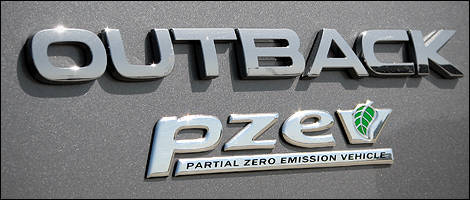The automotive world is constantly swirling with abbreviations that confuse, baffle and frustrate shoppers and enthusiasts alike. Now, there's another one on the scene- this one intended for quick recognition by new car shoppers with a higher-than-average concern for the atmosphere. The abbreviation is 'PZEV', which stands for Partial Zero Emissions Vehicle. You can call it "pee-zev" if you like.
The U.S. Environmental Protection Agency (EPA) says that a PZEV is the cleanest-running gasoline powered car on today's market based on emissions testing for carbon-containing compounds, oxides of nitrogen, particulate matter, and other tailpipe nastiness.
The PZEV designation takes a place above LEV (Low Emissions Vehicles), ULEV (Ultra Low Emissions Vehicles) and SULEV (Super Ultra Low Emissions Vehicles) on the rating scale. It's exceeded only by Bin 1 and ZEV (Zero Emissions Vehicles) like electric cars and scooters.
Subaru is now giving owners the PZEV designation as standard equipment on several of their vehicles- namely the Legacy, Legacy Wagon, and the Outback PZEV Plus. These models are all SmartWay certified by the EPA, as well as recognized in a list of the greenest vehicles available to consumers.
So what makes a PZEV a PZEV? Basically, four key changes to Subaru's 2.5 liter boxer engine elevate its emissions performance to the PZEV level.
The first two changes deal with evaporation of unburned fuel. A special dual-filtration air intake system traps and filters unburned gasoline that winds up left inside the engine when it's turned off. Rather than evaporate and wind up in the atmosphere, this leftover fuel is absorbed by a charcoal canister.
Additionally, a set of more precisely controlled fuel injectors are installed. These injectors close 'tighter' when they're not in use- further helping to prevent fuel leakage.
The second two changes deal with reducing emissions of harmful chemicals from the combustion process through a more powerful catalytic converter. PZEV cars from Subaru have a finer mesh inside their catalytic converter, as well as optimized placement of the precious metals that coat it.
This precious-metal coated mesh enables an exhaust cleansing chemical reaction once it heats up. Since the PZEV catalytic converter has twice the effective cleaning surface area of a standard unit, a greater level of harmful exhaust chemicals can be neutralized.
The chemical reaction at play can only work effectively when the catalytic converter is hot, which leads us to the final PZEV modification- the engine computer. The engine's electronic brain is re-tuned in PZEV cars to run the powerplant very hot at start up, helping the catalytic converter heat up more quickly so it can start doing its job faster.
At the end of the day, these four changes enable ninety percent cleaner emissions than the average new vehicle, and exhaust that's actually cleaner than the air in many smoggy cities.
"We are delighted to offer Canadians the opportunity to purchase a vehicle that reduces their impact on the earth while retaining the fun, freedom, confidence and control that Legacy and Outback deliver," said Katsuhiro Yokoyama, president and CEO of Subaru Canada Inc.
The Subaru PZEV models are on sale now.
photo:Olivier Delorme
The U.S. Environmental Protection Agency (EPA) says that a PZEV is the cleanest-running gasoline powered car on today's market based on emissions testing for carbon-containing compounds, oxides of nitrogen, particulate matter, and other tailpipe nastiness.
The PZEV designation takes a place above LEV (Low Emissions Vehicles), ULEV (Ultra Low Emissions Vehicles) and SULEV (Super Ultra Low Emissions Vehicles) on the rating scale. It's exceeded only by Bin 1 and ZEV (Zero Emissions Vehicles) like electric cars and scooters.
 |
Subaru is now giving owners the PZEV designation as standard equipment on several of their vehicles- namely the Legacy, Legacy Wagon, and the Outback PZEV Plus. These models are all SmartWay certified by the EPA, as well as recognized in a list of the greenest vehicles available to consumers.
So what makes a PZEV a PZEV? Basically, four key changes to Subaru's 2.5 liter boxer engine elevate its emissions performance to the PZEV level.
The first two changes deal with evaporation of unburned fuel. A special dual-filtration air intake system traps and filters unburned gasoline that winds up left inside the engine when it's turned off. Rather than evaporate and wind up in the atmosphere, this leftover fuel is absorbed by a charcoal canister.
Additionally, a set of more precisely controlled fuel injectors are installed. These injectors close 'tighter' when they're not in use- further helping to prevent fuel leakage.
The second two changes deal with reducing emissions of harmful chemicals from the combustion process through a more powerful catalytic converter. PZEV cars from Subaru have a finer mesh inside their catalytic converter, as well as optimized placement of the precious metals that coat it.
This precious-metal coated mesh enables an exhaust cleansing chemical reaction once it heats up. Since the PZEV catalytic converter has twice the effective cleaning surface area of a standard unit, a greater level of harmful exhaust chemicals can be neutralized.
The chemical reaction at play can only work effectively when the catalytic converter is hot, which leads us to the final PZEV modification- the engine computer. The engine's electronic brain is re-tuned in PZEV cars to run the powerplant very hot at start up, helping the catalytic converter heat up more quickly so it can start doing its job faster.
At the end of the day, these four changes enable ninety percent cleaner emissions than the average new vehicle, and exhaust that's actually cleaner than the air in many smoggy cities.
"We are delighted to offer Canadians the opportunity to purchase a vehicle that reduces their impact on the earth while retaining the fun, freedom, confidence and control that Legacy and Outback deliver," said Katsuhiro Yokoyama, president and CEO of Subaru Canada Inc.
The Subaru PZEV models are on sale now.
photo:Olivier Delorme


